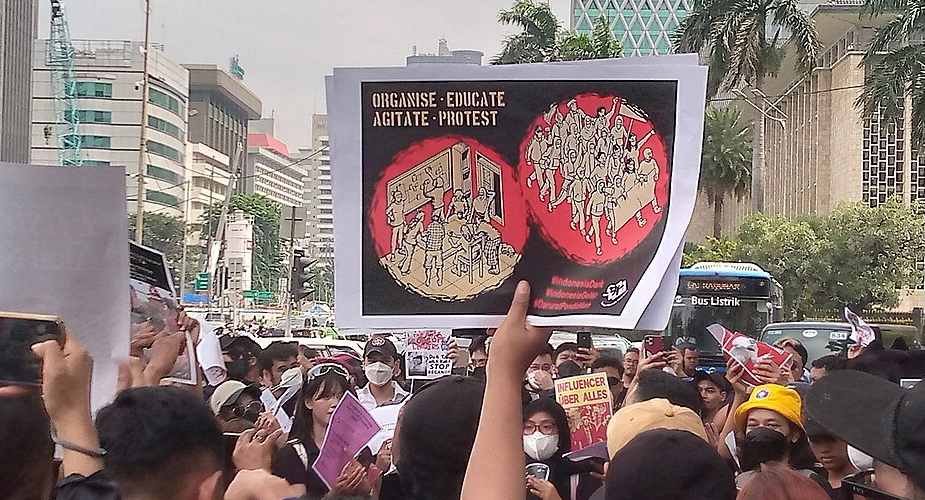Manufacturing workers in Tangerang make a special effort to look good
Nicolaas Warouw
As the morning sun begins to shine, Ida prepares to go to work at a garment factory where top international brands of sportswear are produced. It takes nearly an hour for her to wash, fetch water, and bathe because she has to share the well, toilets, and bathrooms with other residents in her lodging complex. Although little time remains before she must leave for work, she folds a thin blanket on the bare floor of her rented room. She waits for the iron to heat then carefully irons her work-shirt before hanging it up. She then irons her long trousers with the same meticulousness. She sets off to work in her neatly-ironed uniform, her make up, her perfume, and her fashionable high-heeled shoes.
The morning mikrolet, a small van used as public transport in the industrial town of Tangerang, is always fully-packed during rush hour. Most of the passengers are female workers heading to work in local factories. None of them would say it is a pleasant experience. There is no space to stretch their legs or straighten their bodies, and the air smells of industrial pollution and uncovered rubbish. High humidity and traffic jams make the trip even more uncomfortable.
Ida and the mikrolet’s other young female passengers create a striking contrast to their surroundings. Their faces are brightened with powder and they smell of soap or anti-perspirant. When they alight, they briefly parade their carefully-groomed bodies before disappearing into the enormous industrial complexes where they work.
Quest for modernity
How much effort have these young women put into their appearance, the prologue to their mundane performance as wage labourers in industrial factories? Is that effort worthwhile when evidence of it dissolves the moment they set foot into the sweatshop? For Ida, self-presentation is not merely an uncritical mimicry of images and beauty rituals she learns from pop magazines or television sinetron increasingly accessible by the rural population. Her appearance represents her quest for modernity, a quality not available in the rural setting where she grew up.
The importance of self-presentation for working-class women such as Ida seems to suggest that the New Order succeeded in giving dignity to industrial workers. Improved education provided Ida and her classmates with high hopes of a better life in their future and a promise of upward social mobility. Factory smokestacks were a recurring image in their school textbooks. The smokestacks represented development, the holy grail of the Suharto era. It is no coincidence, therefore, that these village girls dream of moving to the city and working in a factory.
Factory workers’ uniforms are part of the realisation of that dream. They communicate young rural migrants’ newly-acquired modern identity. The uniforms differentiate factory workers from their rural counterparts, but also from other urban workers, such as domestic servants, petty traders, and mikrolet drivers. Factory employment also offers workers steady income, which they use to purchase items symbolising their literacy in modern urban culture. Their growing eloquence in urban symbols also includes techniques for crafting the presentation of self. In everyday life, this translates into the intricacies of Ida’s morning rituals with her iron, her uniform, and her make up.
Covert resistance
At the same time, however, this self-presentation is an attempt to counter the demeaning markers of working class existence. It is a conscious attempt to express resistance against the social stigma of their deprivation and subjugation in the face of the state and corporate capitalism. Workers come to Tangerang with dreams of modernity, only to find themselves sentenced to hard labour and life in a slum. Their experiences of capitalism leave them vulnerable in their efforts to establish modern identities. Self-presentation, therefore, demonstrates covert cultural resistance to the poverty and powerlessness of manufacturing workers. It provides them with a space in which they are able to reject domination in the workplace and state denial of workers’ aspirations.
Ida emerges from her shift in the factory with a weary expression and lustreless eyes. She no longer cares about her now-rumpled uniform or the odour of her exhausted body. All signs of her time-consuming morning routine are gone after ten hours in the sweatshop. Yet tomorrow morning she will do it all again.
Nicolaas Warouw (jnw@coombs.anu.edu.au) is a PhD student in the Department of Anthropology, RSPAS, at the Australian National University.











